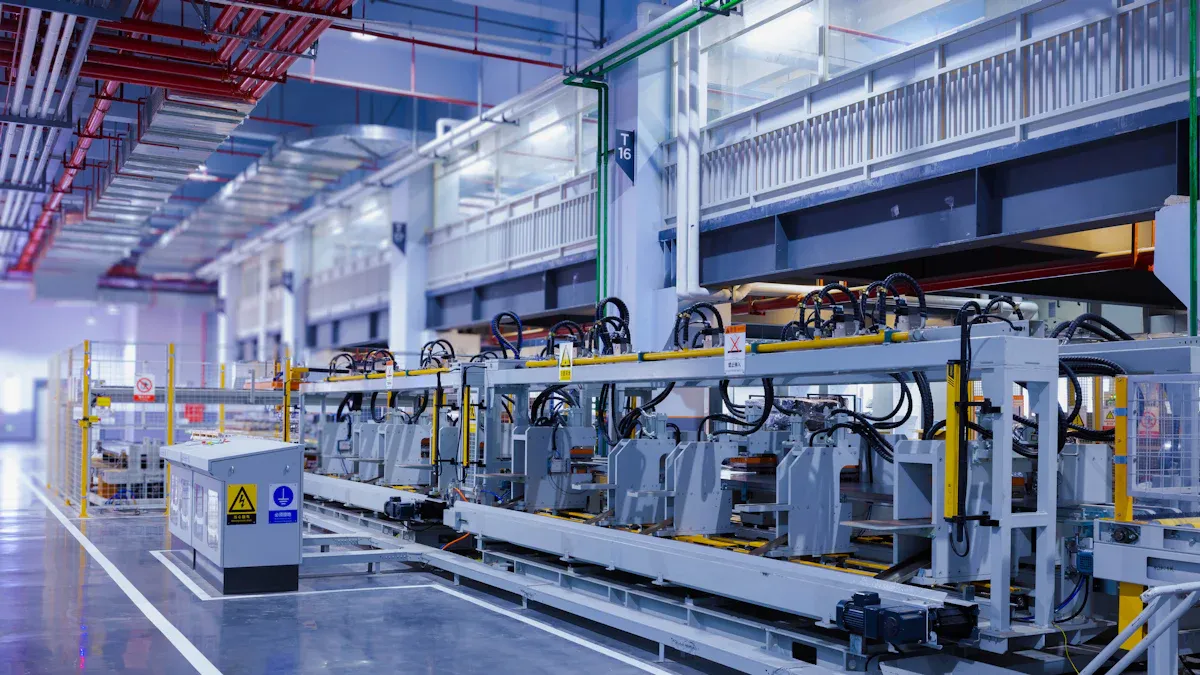How Die Casting Factories Implement Effective Waste Sorting

Efficient waste sorting in die casting factory operations reduces pollution and saves time. Properly separating materials such as metal, plastic, and chemicals ensures improved recycling and disposal processes. It also aids in compliance with regulations and prevents fines through organized waste management. Implementing smart strategies, like categorizing waste into safe and hazardous types, simplifies storage. Advanced tools, such as waste-sorting machines, enhance accuracy and contribute to environmental sustainability.
The Importance of Waste Sorting in Die Casting Factory
Environmental Benefits of Waste Sorting
Sorting waste in die casting factories helps protect the environment. Separating recyclables like metals, plastics, and paper reduces landfill waste. This prevents harmful materials from polluting soil and water. Recycling metals also saves natural resources by reducing mining needs.
Proper sorting also cuts greenhouse gas emissions. For instance, recycling aluminum uses much less energy than making new aluminum. By sorting waste well, you help create a cleaner planet for future generations.
Operational Efficiency and Cost Savings
Sorting waste correctly makes factory operations faster and more efficient. It organizes recycling and disposal, saving time and resources. Many factories have seen big improvements:
Yearly waste dropped by 42 tons.
Energy use decreased by 37%.
Water for cleaning parts was cut by 76%.
Defect rates fell from 3.8% to 0.7%.
These changes show how sorting waste saves money and helps the environment. Better waste management lets factories use resources wisely and work more productively.
Regulatory Compliance and Industry Standards
Following waste sorting rules is important to avoid fines. Governments and industries have strict rules for handling harmful waste like chemicals. Sorting waste properly ensures your factory meets these rules.
Being compliant also improves your factory’s reputation. Customers and partners respect businesses that care about the environment. By following good practices, your factory can lead in sustainability efforts.
Waste Sorting Methods in Die Casting Factories
Material Separation: Metals, Slag, and Other Leftovers
Sorting materials is key to managing waste in die casting factories. Metals, slag, and other leftovers can be separated to recycle more and waste less. Metals like aluminum and zinc can be reused forever without losing their quality. Slag, made during casting, can be treated to recover useful parts.
Sorting construction and demolition (C&D) waste helps recycling and saves money. Workers must sort by hand to get clean materials. This is especially important for dangerous items like wood, where clean wood must be separated from dirty wood. Good sorting practices improve recycling results.
Factories can use these methods to save valuable materials. Combining hand sorting with machines makes the process faster and better.
Recycling Systems for Scrap Metal, Plastics, and Paper
Modern recycling systems are important for sorting waste in die casting factories. These systems handle scrap metal, plastics, and paper efficiently. Each type of material needs its own recycling steps to stay useful.
Material | Recycling Steps | Notes on Efficiency |
|---|---|---|
Plastics | Sorted, shredded, washed, melted, and turned into pellets. | Works well for thermoplastics but may lose quality after many cycles. |
Paper | Pulped, screened, cleaned, pressed, and dried into new paper. | Quality stays good if processed right, but dirt must be removed. |
Metals | Collected, sorted, shredded, melted, and shaped into new items. | Metals can be reused forever with little quality loss, making them very efficient. |
Recycling systems cut waste and save resources. For example, recycling metals uses less energy than mining new ones. Recycling plastics and paper also protects nature and lowers pollution.
Dross Reprocessing: Finding Value in Waste
Dross, leftover from die casting, has useful materials that can be recovered. Factories can use dross reprocessing systems to get metals like aluminum and zinc. This reduces waste and adds economic value.
Goal | Description |
|---|---|
Environmental Solution | Turn aluminum dross into a helpful material (Fe-Al LDH adsorbent) to solve waste problems. |
Water Purification | Clean arsenic-contaminated water using the Fe-Al LDH material. |
Reprocessing dross cuts waste and helps the planet. For example, treated dross can clean water, turning waste into something useful. This helps both factories and the environment.
Handling Chemical and Hazardous Waste Safely
Managing chemical and hazardous waste in factories needs strict care. These materials must be separated from other waste to avoid harm. Items like solvents, oils, and cleaners need special handling and storage.
Key Practices for Safe Handling:
Labeling and Storage: Mark hazardous waste clearly with labels. Keep chemicals in strong, sealed containers away from heat.
Screening Processes: Check waste carefully to find hidden dangers. For example, oxygen in waste can cause explosions if missed.
Training Programs: Teach workers how to handle dangerous materials safely. Show them emergency steps and proper disposal methods.
Safety Note: In 2015, the EPA found 26,237 sites made 33.6 million tons of hazardous waste. Over 6 million tons were solid waste. An explosion at a waste plant showed the danger of poor screening. Missing risks can lead to serious accidents.
By using these steps, factories can lower risks and follow rules. Safe handling protects workers, nature, and the factory’s image.
Managing Residual Waste: Gloves, Sandbelts, and Living Garbage
Residual waste includes gloves, sandbelts, and trash from daily use. These items often can’t be recycled but still need proper disposal. Sorting and using the right methods can reduce harm to the environment.
Steps to Manage Residual Waste:
Categorize Waste: Sort gloves, sandbelts, and trash separately from recyclables.
Use Specialized Bins: Place non-recyclable waste in special bins to avoid mixing.
Partner with Disposal Services: Work with experts to handle waste that can’t be recycled.
Managing residual waste keeps the factory clean and organized. It also helps keep recyclable items free from contamination.
Tip: Try reusing gloves and sandbelts when possible. For example, gloves used for safe tasks can be cleaned and used again, cutting down waste.
By handling residual waste well, factories create cleaner spaces and support sustainability.
Technological Advancements in Waste Sorting
Automated Sorting Systems for Enhanced Efficiency
Automated systems have changed how waste is sorted in factories. They use smart sensors and robots to quickly separate materials. These systems sort metals, plastics, and other waste with great accuracy. This makes the process faster and reduces mistakes.
For example, sensors can tell metal types by color or makeup. Robotic arms then place the materials into the right bins. This keeps materials clean, which is important for recycling. Automated systems also lower labor costs and keep workers safe from dangerous waste.
Tip: Adding automated sorting systems can make your factory faster and greener.
Digital Monitoring and Data Analytics for Waste Management
Digital tools help factories improve waste sorting. Monitoring systems watch waste levels and sorting steps in real time. This data shows where problems are and helps fix them.
Analytics software studies waste trends. It shows which materials are wasted most and gives ideas to reduce waste. These tools help factories save resources and improve sorting plans.
Some systems even predict future waste levels. They use production schedules to plan ahead. Digital tools make waste sorting smarter and more efficient.
Waste Heat Recovery Systems in Die Casting Operations
Waste heat recovery systems reuse heat made during casting. This saves energy and cuts costs. The heat can be used for other tasks, like warming materials or keeping the factory warm.
Here’s how these systems help:
Metric | Value |
|---|---|
Less natural gas used | |
Energy saved yearly | 300 MWh/year |
Payback time | About 3 years |
Burner energy cut | 50% to 80% |
Energy from waste heat | Up to 63% of new energy needed |
These systems save energy and lower pollution. They help factories spend less while protecting the planet.
Note: Waste heat recovery systems are a great way to save energy and reduce waste.
Future Trends in Waste Sorting for Die Casting Factory
Circular Economy Models in Die Casting
The future of waste management will use circular economy models. These models aim to reuse materials and cut waste. Instead of throwing away leftovers, factories can recycle metals and plastics. For example, aluminum scraps can be melted and used again. This reduces the need for new raw materials.
Using a circular economy also lowers costs and helps the planet. Factories can design products that are easier to recycle. This creates a production cycle with less waste and more sustainability.
Innovations in Sustainable Materials and Processes
New materials and methods are changing how factories handle waste. Scientists are creating biodegradable plastics for packaging. These break down naturally, easing pressure on recycling systems.
Better casting techniques now produce less waste during manufacturing. For example, precision casting uses only the material needed. This leaves fewer scraps to sort and recycle. These changes make waste sorting easier and support a greener future.
Policy and Regulatory Changes Driving Waste Management Practices
Governments are making stricter rules for managing waste. Factories may soon need to sort and recycle waste more carefully. These rules aim to reduce landfill use and encourage sustainable practices.
Some areas now require factories to report waste and recycling rates. Following these rules helps avoid fines and stay compliant. Using advanced sorting methods can also improve factory efficiency.
Tip: Watch for new waste management laws in your area to stay prepared.
FAQ
What kinds of waste can be recycled in die casting factories?
Factories can recycle metals, plastics, paper, and wood. Metals like aluminum and zinc are great because they stay strong after recycling. Plastics and paper need to be sorted and cleaned first. Wood pallets can be reused or turned into other products.
How do factories safely manage hazardous waste?
Hazardous waste, like chemicals and oils, is kept in sealed, labeled containers. Workers are trained to handle these materials carefully. Special disposal services take care of removing them safely. These steps keep workers and the environment safe.
Why is sorting waste important for following rules?
Sorting waste helps factories follow government rules for handling dangerous and recyclable materials. It avoids fines and legal trouble. It also shows your factory cares about the planet and responsible waste management.
Can items like gloves and sandbelts be used again?
Yes, some leftover items can be reused. For example, gloves used for safe tasks can be washed and used again. Sandbelts might be used for less important jobs. Reusing these things cuts down on waste and saves money.
What tools make waste sorting better in factories?
Automated systems, AI, and digital tools help sort waste faster and more accurately. These tools find materials quickly, reduce mistakes, and improve recycling. Using them makes factories work better and helps the environment.
See Also
A Supplier's Guide to CBAM and Sustainable Casting Practices
Essential Inspection and Testing Steps for Die Casting Molds
Comprehensive Guide for CAD Design in Die Casting
Seven Essential Steps to Collaborate with Global Diecast Factories
Exploring How CAE Analysis Enhances Die Casting Design Benefits
About Hunan Puka
Established in 2016 and based in Hunan, China, with a liaison point in Berlin, we are a Tier 2 supplier for the automobile industry. We specialize in the production of customized aluminum die-casting parts designed for machines with a closing force ranging from 280 to 1250 tons, with subsequent manufacturing process CNC machining and surface treatment. Our commitment to quality is reflected in our accredited quality management system, certified by ISO9001:2015 and IATF16949:2016 standards.


